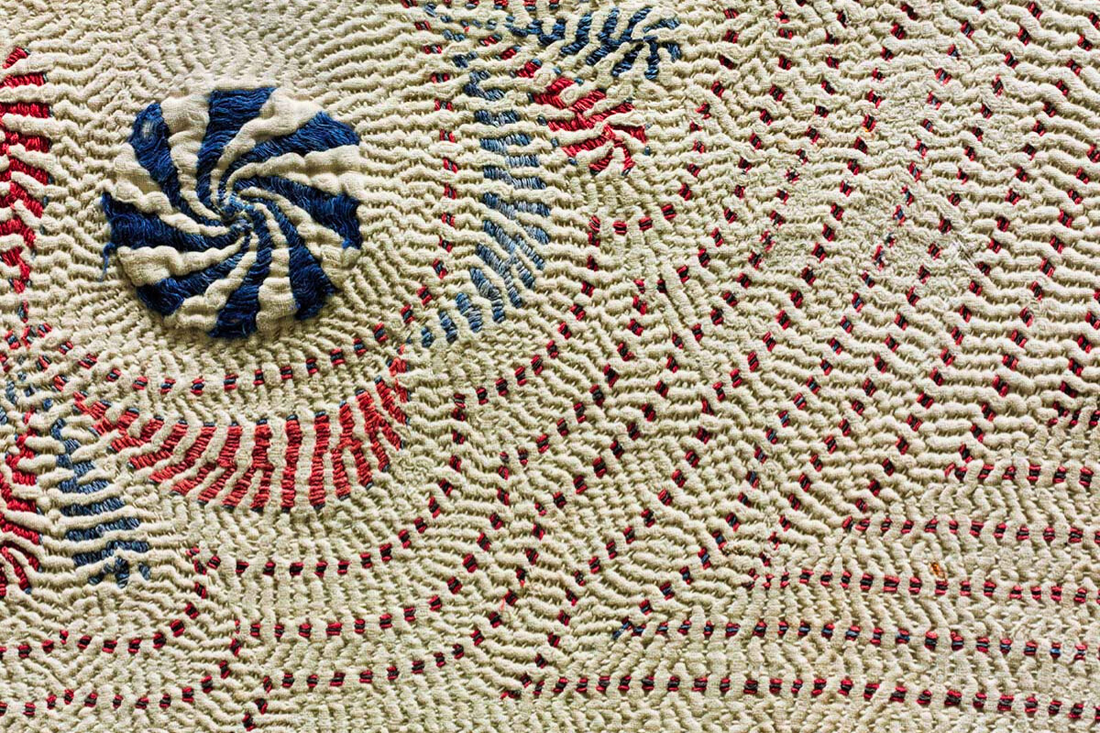
Layers of Meaning | KANTHA
Share
A journey into Bengal’s rich textile legacy.
Art by Women
Women have traditionally used kantha embroidery as a way to document their lives and experiences. Working within a structured layout of grids, borders, and symmetrical patterns, they found room for creativity and personal expression. Through carefully chosen motifs, they depicted their surroundings, interests, emotions, fears, and aspirations. The art of kantha was more than decorative, it was a form of storytelling. Passed down through generations, their refined needlework techniques allowed them to transform fabric into both objects of beauty and vessels for their inner worlds and personal narratives.
 Embroidery patchwork in running stitch Kantha.
Embroidery patchwork in running stitch Kantha.
The Original Circular Design
Long before sustainability became a global concern, women in Bengal were living it through the tradition of kantha. Old, worn-out saris were stitched together with threads from sari borders to create quilts. When these quilts tore, they were patched with fabric scraps. Eventually, they were repurposed into smaller items, coin purses, diapers, cleaning cloths, until the fabric completely wore out.
This wasn’t just thrift; it was a thoughtful, resourceful way of life rooted in care, creativity, and respect for materials. These women were practicing circular design long before it had a name.

One side of a Kantha.
Bengal: A Land of Deep Roots and Diverse Influences
Bengal, now split into Bangladesh and West Bengal (India), is a region shaped by centuries of shared language, culture, and history. Though divided in 1947, its spirit remains unified in memory and tradition.
Its name traces back to the ancient kingdom of Banga, with roots in early rice-growing communities along the fertile delta of the Ganga, Brahmaputra, and Meghna rivers. Agriculture still thrives here, nourished by monsoons and a temperate climate.
Thanks to its rich natural resources, rice, jute, indigo, and legendary muslins, Bengal drew waves of invaders and traders: Sultans, Mughals, Portuguese, Dutch, and British. Each left behind layers of language, craftsmanship, and cuisine, making Bengal a vibrant cultural crossroads.
Walking through rural West Bengal today, one can still feel this connection, rows of kantha stitches mirror the rows of paddy in the fields, both quiet testaments to a land woven with memory and meaning.

Details of a Kantha with running stitch and detached chain stitch combinations.
Threads of Memory and Meaning
Unlike many traditional textile crafts led by men, kantha embroidery was created entirely by women in Bengal, using layers of worn cloth and thread pulled from old saris. These textiles were more than quilts, they were personal records, filled with symbols of love, protection, and everyday life.
Kantha were often gifted for weddings or births, stitched with motifs like fish for fertility, mahrabs for prayer, or eyes to ward off evil. Women placed these designs within grids, ensuring they could be viewed from all sides when laid flat, showing not only artistic skill but thoughtful composition.
The rich variety of motifs reflects Bengal’s layered culture and spiritual life. Designs often mirrored alpona, ritual floor art made with rice paste, and were sometimes embroidered during religious fasts (vrata) for loved ones.
Passed through generations, kantha carried stories, traditions, and emotion, all made without formal training or new materials. They exemplify sustainability, resilience, and quiet creativity, proof that even within domestic boundaries, women created enduring works of art.
 Bagru block printet Kantha.
Bagru block printet Kantha.
Recycling, Restitution, and the Life of Cloth
In Bengal, textiles lived many lives. Men wore dhotis or lungis, women draped saris, mostly in cream or white, often edged in red, blue, or black. When these garments became too worn to wear, women saved the cloth, layering and stitching it into kantha quilts using threads pulled from old sari borders. These quilts, embroidered with intimate narratives and motifs, were gifted, mended, and passed down through generations. Even in their final stages, they were repurposed into smaller items like coin purses or cleaning cloths, used until nothing remained. The subtle palettes of old kantha reflect the materials at hand, though contemporary makers now embrace vibrant fabrics and threads. Kantha is “a restitution of wholeness”, a craft where scraps are stitched into memory, care, and enduring beauty.
 Details of a Kantha showing interlaced running stich.
Details of a Kantha showing interlaced running stich.
